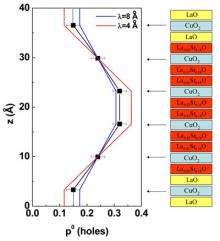Counting the 'Holes' in High-Temperature Superconductors

(PhysOrg.com) -- As part of the effort to better understand how superconductors transport electricity with zero resistance, a team of researchers has demonstrated a new way to count the number of a material's "holes" - locations where electrons are absent. Knowing more about holes, which, like electrons, are thought to interact with each other to produce superconducting current within a material, could help scientists develop superconductors for applications like more-efficient power transmission or magnetic-levitation high-speed trains.
The researchers, from the University of Illinois, Brookhaven National Laboratory, and the University of Paris, focused on copper-oxide compounds, called cuprates, which operate at temperatures warmer than traditional superconductors but still far below freezing. The ultimate goal for researchers is to design superconducting materials that function closer to room temperature, and therefore, are practical for everyday use.
Cuprates normally act as insulators but become superconductors when electrons are removed in a process known as "doping" holes into the material. A material is considered optimally doped when it is superconducting at the highest temperature possible. When the material is doped past this point, the superconductivity often vanishes.
In this study, the researchers built a sandwich of alternating layers of two cuprates: LSCO, which contains lanthanum, strontium, copper, and oxygen; and LCO, which lacks the strontium. They grew this complex structure using a unique molecular beam epitaxy system in Brookhaven's Condensed Matter Physics and Materials Science Department. This machine allows researchers to deposit materials atom by atom, giving precise control of each layer's thickness.
"Using molecular beam epitaxy, our collaborators at Brookhaven were able to achieve excellent control of the amount of material that goes in the sample," said University of Illinois researcher Serban Smadici. "That's very difficult to do, and it's one of the driving forces of this project."
This particular structure was made of 15 segments of precisely measured two unit cells of LCO and four unit cells of LSCO. Anything less than the highest precision, Smadici said, would alter the layer's properties.
Neither of the two materials used in the study is superconducting by itself - LCO was used in its naturally insulating form and LSCO was overdoped to the point where its superconductivity disappeared. Surprisingly, though, the overall structure is superconducting at 38 Kelvin, about -235 degrees Celsius.
"When you put these layers together, the overall structure actually becomes superconducting," Smadici said. "The question is why? Figuring out the answer to this question requires determining where the holes are in this structure."
They did that at NSLS beamline X1B using resonant soft x-ray scattering, a technique that allows researchers to selectively probe the holes. By measuring the reflectivity of the structure at different angles, they pinpointed the number of holes in each individual layer.
Their results, which were published in the March 13, 2009, edition of Physical Review Letters, show that many of the holes actually moved from the overdoped LSCO to the LCO. This creates optimally doped LCO - the driver of the surprise superconductivity in the multilayered structure.
"Our results demonstrate the utility of resonant soft x-ray scattering for probing the holes near interfaces separately of the atomic structure," Smadici said. "They also provide evidence on the importance of interfaces to novel superconducting materials."
Now, the researchers are using this analytic synchrotron technique on other multilayer superconducting structures.
"This work is far from over," Smadici said.
Other authors include James Lee, Shuai Wang, and Peter Abbamonte, from the University of Illinois; Gennady Logvenov, Adrian Gozar, and Ivan Bozovic, from Brookhaven National Laboratory; and Catherine Deville Cavellin, from Brookhaven and the University of Paris.
More information: S. Smadici, J.C.T. Lee, S. Wang, P. Abbamonte, G. Logvenov, A. Gozar, C. Deville Cavellin, I. Bozovic, "Superconducting Transition at 38 K in Insulating-Overdoped La2CuO4-La1.64Sr0.36CuO4 Superlattices: Evidence for Interface Electronic Redistribution from Resonant Soft X-Ray Scattering," PRL, 102, 107004 (2009).
Provided by Brookhaven National Laboratory


















